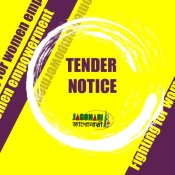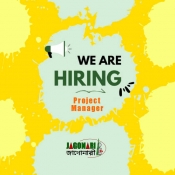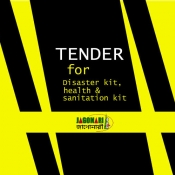LEARNING REVIEW REPORT—Cyclone Anticipatory Action planning and response trial in Barguna, Project

Barguna district, situated on the shores of the Bay of Bengal, is highly vulnerable to various natural hazards. To enhance disaster response capacity and pre-disaster preparedness for 606 households through Anticipatory Action (AA) programs, Jago Nari implemented a project titled “Cyclone Anticipatory Action Planning and Response Trial” in four unions: Badarkhali, Gaurichona, Phuljhuri, and Dhalua in Barguna Sadar.
The primary goal of the learning review is to understand the relevance, timeliness, efficiency, and effectiveness of the AA interventions’ piloting and capture challenges and key learnings with appropriate recommendation
The study employed qualitative methods, including 6 in-depth interviews (IDI), 6 focus group discussions (FGD), 18 key informant interviews (KII), and 4 case studies for data collection and analysis. Data were gathered from both primary and secondary sources.
The AA programs were highly relevant to the targeted community, as marginalized groups faced food insecurity, unemployment, and other hardships due to disasters. Government assistance in these situations is notably insufficient, leaving affected families unable to recover effectively. Participants in the AA project, including those in Cash-for-Work (CFW) and Anticipatory Cash Grants (ACG), were selected through a participatory approach and were satisfied with the selection process.
The Cash-for-Work (CFW) grant of 400 BDT for 5 days provided temporary financial relief, though it was insufficient given current market prices. In contrast, the one-time 5,000 BDT payment from the Anticipatory Cash program was deemed sufficient by recipients to mitigate disaster-related losses.
Grants were distributed through the Nagad Mobile Money Transfer (MMT) system, allowing participants to withdraw funds quickly and easily. Safeguarding and CFM mechanisms were in place, and recipients were very satisfied with the cash distribution process.
The AA grants were used effectively by recipients. CFW grants were spent on food, transportation, medical expenses, clothing, shelter repairs, agricultural inputs, and hygiene kits. ACG funds were used for disaster preparedness and adaptation, such as shelter repairs, fuel collection, emergency evacuation, livestock feed, and agricultural inputs, as well as ensuring food security and purchasing basic household items, transportation, education, clothing, and medical expenses.
The AA programs benefited the targeted people by ensuring food security, contributing to health treatment, and meeting basic needs. They also supported disaster preparedness initiatives like house repairs, fuel collection, dry food storage, and cash in hand for post shelter repairing. The CFW program increased women’s dignity and created employment opportunities for them. Additionally, embankments and roads repaired through CFW have protected the community from flooding.
Regarding institutional capacity, Oxfam is a pioneer INGO in Bangladesh has been implementing/implemented huge number of humanitarian response and disaster resilience project including Anticipatory Action. Before this project, Jago Nari had experience with anticipatory action activities supported by various donors and INGOs, including Start Fund Bangladesh, Save the Children, and CARE Bangladesh. However, their interventions mainly involved material distribution just before calamities. They have a framework, skilled staff, and a dedicated pool of volunteers ready to implement such projects.
However, there is room for improvement in their institutional capacity, such as comprehensive training programs, increased collaboration with local and international partners, infrastructure development, working with government agencies to establish clear AA policies, and securing reliable financing through partnerships.
Policy advocacy is needed to recognize anticipatory action as an effective component of disaster management. Since it is not included in the government’s strategy paper, it is crucial to inform disaster management stakeholders about its importance.
The project effectively engaged local Disaster Management Committees (DMCs) and stakeholders in community-based disaster preparedness. They raised awareness about preparedness initiatives, participated in the Cash-for-Work (CFW) program, coordinated land allocation for infrastructure, prepared cyclone centers, and disseminated government-issued warnings. With project support, the DMCs now conduct regular meetings and are more active than before. Additionally, Oxfam and Jago Nari developed and shared an Anticipatory Action Management Protocol with DMCs and stakeholders, incorporating their feedback.
The scalable best practices of the project are; 1. project participant selection through engaging the local community people and local government. 2. AA and CFW cash grant support provided through mobile banking/Nagad including cash out charge and 3. developing AAM Protocol, 4. developing a district vulnerability profile, 5. gender inclusion, 6. Cash for Work (CFW)
As a lesson learned, improving the area is scope to have proper planning/ guidance to use the anticipatory money if there is no disaster within the project period in the working area.
The emerging opportunity that needs to be adjusted for future intervention, should be increased a strong coordination mechanism among the different stakeholders (Disaster Management Committees-DMCs, School Management Committees-SMCs, Shelter Management Committees, Cyclone Preparedness Programme-CPP Bodies, etc) for effective disaster preparedness to minimize the shocks and damage of any disaster.
The recommendations are;1. duration of the DP/DRR related project/s should be at least 2 years, 2. Anticipatory Action Cash Grant is very much effective. So, this type of initiative should be incorporated in future projects and replicated in other areas. 3. There is scope to work for the actively functioning of DMCs to effective disaster preparedness through utilization of AA programmes. 4.Cash transfer through mobile banking should be encouraged in future as it is very much convenient and secured for the project participants. 5. Standard benefit package and capacity building initiatives for project staff should be considered. 6. Advocacy initiative is necessary to construct a sufficient number of cyclone shelters in coastal areas.7. All the best practices should be incorporated in future projects and replicated in other disaster-prone areas.
Published on: Monday, 26 May 2025, 06:32 pm ▪ Total View of this Page: 286










